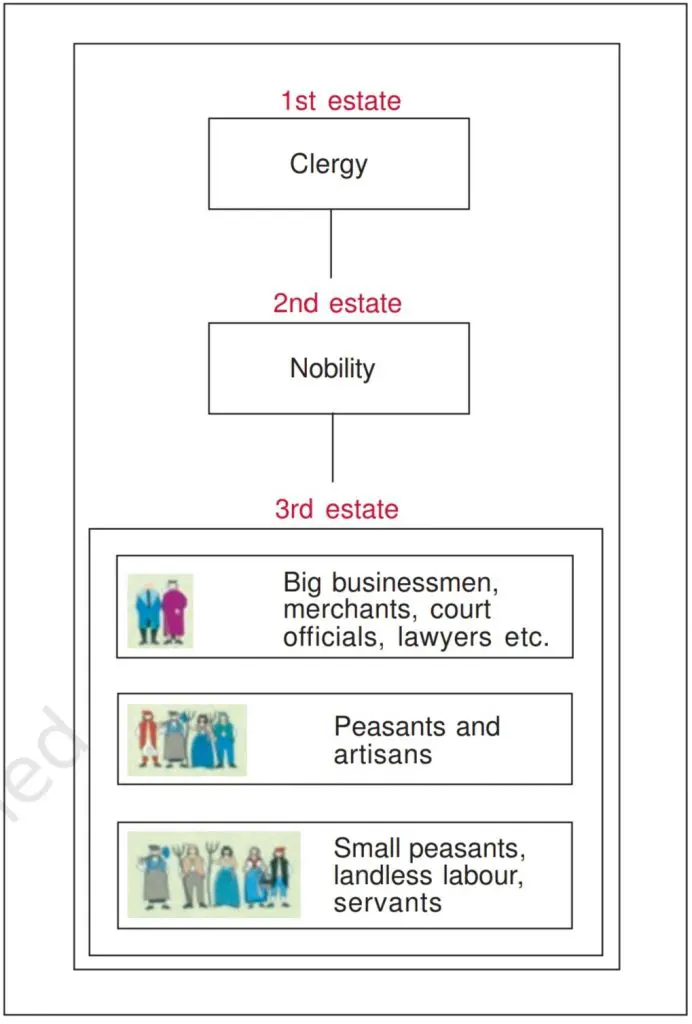India and the Contemporary World 1 French Revolution
India and the contemporary world 1 The French Revolution
India and the contemporary world 1 french revolution On the morning of 14 July 1789, the city of Paris was in a state of alarm. The king had commanded troops to move into the city. Rumours spread that he would soon order the army to open fire upon the citizens. Some 7,000 men and women gathered in front of the town hall and decided to form a peoples’ militia. They broke into a number of government buildings in search of arms.
Finally, a group of several hundred people marched towards the eastern part of the city and stormed the fortress-prison, the Bastille, where they hoped to find hoarded ammunition. In the armed fight that followed, the commander of the Bastille was killed and the prisoners released – though there were only seven of them. Yet the Bastille was hated by all, because it stood for the despotic power of the king. The fortress was demolished and its stone fragments were sold in the markets to all those who wished to keep a souvenir of its destruction.
The days that followed saw more rioting both in Paris and the
countryside. Most people were protesting against the high price of bread.
Much later, when historians looked back upon this time, they saw it as the beginning of a chain of events that ultimately led to the execution of the king in France, though most people at the time did not anticipate this outcome. How and why did this happen?
French Society During the Late Eighteenth Century
In 1774, Louis XVI of the Bourbon family of kings ascended the throne of France. He was 20 years old and married to the Austrian princess Marie Antoinette. Upon his accession the new king found an empty treasury. Long years of war had drained the financial resources of France. Added to this was the cost of maintaining an extravagant court at the immense palace of Versailles. Under Louis XVI, France helped the thirteen American colonies to gain their independence from the common enemy, Britain. The war added more than a billion livres to a debt that had already risen to more than 2 billion livres. Lenders who gave the state credit now began to charge
10 percent interest on loans. So the French government was obliged to spend an increasing percentage of its budget on interest payments alone. To meet its regular expenses, such as the cost of maintaining an army, the court, running government offices or universities, the state was forced to increase taxes. Yet even this measure would not have sufficed. French society in the eighteenth century was divided into three estates, and only members of the third estate paid taxes.
The society of estates was part of the feudal system that dated back to
the middle ages. The term Old Regime is usually used to describe the
society and institutions of France before 1789.

Peasants made up about 90 percent of the population. However, only a small number of them owned the land they cultivated. About 60 percent of the land was owned by nobles, the Church, and other richer members of the third estate. The members of the first two estates, that is, the clergy and the nobility, enjoyed certain privileges by birth. The most important of these was an exemption from paying taxes to the state. The nobles further enjoyed feudal privileges. These included feudal dues, which they extracted from the peasants. Peasants were obliged to render services to the lord – to work in his house and fields – to serve in the army or to participate in building roads.
The Church too extracted its share of taxes called tithes from the peasants, and finally, all members of the third estate had to pay taxes to the state.
These included a direct tax, called taille, and a number of indirect taxes that were levied on articles of everyday consumption like salt or tobacco. The burden of financing activities of the state through taxes was borne by the third estate alone.
The Struggle to Survive
The population of France rose from about 23 million in 1715 to 28 million in 1789. This led to a rapid increase in the demand for foodgrains. Production of grains could not keep pace with the demand. So the price of bread which was the staple diet of the majority rose rapidly. Most workers were employed as labourers in workshops whose owner fixed their wages. But wages did not keep pace with the rise in prices. So the gap between the poor and the rich widened. Things became worse whenever drought or hail reduced the harvest.
This led to a subsistence crisis, something that occurred frequently
in France during the Old Regime.
A Growing Middle Class Envisages an End to Privileges
In the past, peasants and workers had participated in revolts against increasing taxes and food scarcity. But they lacked the means and programs to carry out full-scale measures that would bring about a change in the social and economic order. This was left to those groups within the third estate who had become prosperous and had access to education and new ideas.
The eighteenth-century witnessed the emergence of social groups, termed the middle class, who earned their wealth through expanding overseas trade and from the manufacture of goods such as woolen and silk textiles that were either exported or bought by the richer members of society. In addition to merchants and manufacturers, the third estate included professions such as lawyers or administrative officials. All of these were educated and believed that no group in society should be privileged by birth. Rather, a person’s social position must depend on his merit. These ideas envisaging a society based on freedom and equal laws and
opportunities for all were put forward by philosophers such as John Locke and Jean Jacques Rousseau. In his Two Treatises of Government, Locke sought to refute the doctrine of the divine and absolute right of the monarch. Rousseau carried the idea forward, proposing a form of government based on a social contract between people and their representatives. In The Spirit of the Laws, Montesquieu proposed a division of power within the government between the legislative, the executive, and the judiciary. This model of government was put into force in the USA after the thirteen colonies declared their independence from Britain. The American constitution and its guarantee of individual rights was an important example for political thinkers in France.
The ideas of these philosophers were discussed intensively in salons and coffee-houses and spread among people through books and newspapers. These were frequently read aloud in groups for the benefit of those who could not read and write. The news that Louis XVI planned to impose further taxes to be able to meet the expenses of the state generated anger and protest against the system of privileges.
Some Important Dates
| 1774 | Louis XVI becomes king of France, faces empty treasury, and growing discontent within society of the Old Regime. |
| 1789 | Convocation of Estates General, Third estate forms National Assembly, the Bastille is stormed, peasant revolts in the countryside. |
| 1791 | A constitution is framed to limit the powers of the king and to guarantee basic rights to all human beings. |
| 1792-93 | France becomes a republic, the king is beheaded. The overthrow of the Jacobin republic, a Directory rules France. |
| 1804 | Napoleon becomes emperor of France, annexes large parts of Europe. |
| 1815 | Napoleon defeated at Waterloo. |
The Outbreak of the Revolution
Louis XVI had to increase taxes for reasons you have learnt in the previous section. How do you think he could have gone about doing this? In France of the Old Regime the monarch did not have the power to impose taxes according to his will alone. Rather he had to call a meeting of the Estates-General which would then pass his proposals for new taxes. The Estates-General was a political body to which the three estates sent their representatives. However, the monarch alone could decide when to call a meeting of this body. The last time it was done was in 1614.
On 5 May 1789, Louis XVI called together an assembly of the Estates
General to pass proposals for new taxes. A resplendent hall in Versailles was prepared to host the delegates. The first and second estates sent 300 representatives each, who were seated in rows facing each other on two sides, while the 600 members of the third estate had to stand at the back. The third estate was represented by its more prosperous and educated members. Peasants, artisans, and women were denied entry to the assembly. However, their grievances and
demands were listed in some 40,000 letters that the representatives had brought with them. Voting in the Estates-General in the past had been conducted according to the principle that each estate had one vote. This time too Louis XVI was determined to continue the same practice. But members of the third estate demanded that voting now be conducted by the
assembly as a whole, where each member would have one vote. This was one of the democratic principles put forward by philosophers like Rousseau in his book The Social Contract. When the king rejected this proposal, members of the third estate walked out of the assembly in protest.
The representatives of the third estate viewed themselves as spokesmen
for the whole French nation. On 20 June they assembled in the hall of an indoor tennis court on the grounds of Versailles. They declared themselves a National Assembly and swore not to disperse till they had drafted a constitution for France that would limit the powers of the monarch. They were led by Mirabeau and Abbé Sieyès. Mirabeau was born in a noble family but was convinced of the need to do away with a society of feudal privilege. He brought out a journal and delivered powerful speeches to the crowds assembled at Versailles.
Abbé Sieyès, originally a priest, wrote an influential pamphlet called
‘What is the Third Estate’?
While the National Assembly was busy at Versailles drafting a constitution, the rest of France seethed with turmoil. A severe winter had meant a bad harvest; the price of bread rose, often bakers exploited the situation and hoarded supplies. After spending hours in long queues at the bakery, crowds of angry women stormed into the shops. At the same time, the king ordered troops to move into Paris. India and the contemporary world 1 french revolution, On 14 July, the agitated crowd stormed and destroyed the Bastille.
In the countryside rumors spread from village to village that the lords of the manor had hired bands of brigands who were on their way to destroy the ripe crops. Caught in a frenzy of fear, peasants in several districts seized hoes and pitchforks and attacked chateaux. They looted hoarded grain and burnt down documents containing records of manorial dues. A large number of nobles fled from their homes, many of them migrating to neighbouring countries. Faced with the power of his revolting subjects, Louis XVI finally accorded recognition to the National Assembly and accepted the principle that his powers would from now on be checked by a
constitution. On the night of 4 August 1789, the Assembly passed a decree abolishing the feudal system of obligations and taxes. Members of the clergy too were forced to give up their privileges. Tithes were abolished and lands owned by the Church were confiscated. As a result, the government acquired assets worth at least 2 billion livres.
PDF PREVIEW:-
Download India and the contemporary world 1 french revolution pdf from the below link to get the Chapter from NCERT Book of Class 9 Chapter 1.
- TOPIC: India and the contemporary world 1 French Revolution
- FILE FORMAT: PDF
- PDF SIZE: 4MB
- SOURCE: NCERT CLASS 9
RELATED POST:-
Download India and the Contemporary World 1 of Class 9 PDF
Download India and the Contemporary World 2 of Class 10 PDF
Useful Books for Competitive Exams
Best Books for Competitive Exams [PDF]
Disclaimer: Pavithran.Net doesn’t aim to promote or condone piracy in any way. We do not own any of these books. We neither create nor scan this Book. The Images, Books & other Contents are copyrighted to their respective owners. We are providing PDFs of Books that are already available on the Internet, Websites, and Social Media like Facebook, Telegram, Whatsapp, etc. We highly encourage visitors to Buy the Original content from their Official Sites. If any way it violates the law or if anybody has Copyright issues/ having discrepancies over this post, Please Take our Contact Us page to get in touch with us. We will reply as soon as we receive your Mails.
We Need Your Support. Please Share the Link if it is helpful to your Cherished circle

![Arihant NCERT Examplar Biology Class 12 [2014 Edition]](https://www.pavithran.net/wp-content/uploads/2024/08/Arihant-NCERT-Examplar-Biology-Class-12-2014-Edition-768x1152.webp)




![Complete Guide for RRB Group D Level 1 Exam [4th Edition -2024] - Disha Experts](https://www.pavithran.net/wp-content/uploads/2025/03/Complete-Guide-for-RRB-Group-D-Level-1-Exam-4th-Edition-2024-Disha-Experts-785x1024.webp)